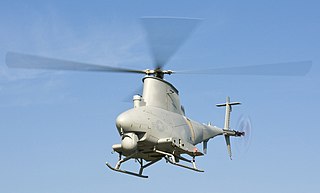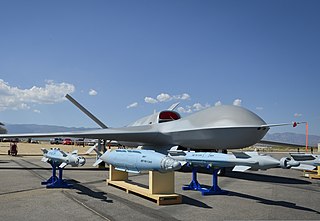Related Research Articles

The Northrop Grumman RQ-4 Global Hawk is a high-altitude remotely-piloted surveillance aircraft. It was initially designed by Ryan Aeronautical, and known as Tier II+ during development. The Global Hawk performs duties similar to that of the Lockheed U-2. The RQ-4 provides a broad overview and systematic surveillance using high-resolution synthetic aperture radar (SAR) and long-range electro-optical/infrared (EO/IR) sensors with long loiter times over target areas. It can survey as much as 40,000 square miles (100,000 km2) of terrain a day, an area the size of South Korea or Iceland.

The AAI RQ-7 Shadow is an American unmanned aerial vehicle (UAV) used by the United States Army, Australian Army and Swedish Army for reconnaissance, surveillance, target acquisition and battle damage assessment. Launched from a trailer-mounted pneumatic catapult, it is recovered with the aid of arresting gear similar to jets on an aircraft carrier. Its gimbal-mounted, digitally stabilized, liquid nitrogen-cooled electro-optical/infrared (EO/IR) camera relays video in real time via a C-band line-of-sight data link to the ground control station (GCS).

The Northrop Grumman MQ-4C Triton is an American high-altitude long endurance unmanned aerial vehicle (UAV) under development for the United States Navy as a surveillance aircraft. Together with its associated ground control station, it is an unmanned aircraft system (UAS). Developed under the Broad Area Maritime Surveillance (BAMS) program, the system is intended to provide real-time intelligence, surveillance and reconnaissance missions (ISR) over vast ocean and coastal regions, continuous maritime surveillance, conduct search and rescue missions, and to complement the Boeing P-8 Poseidon maritime patrol aircraft. Triton builds on elements of the RQ-4 Global Hawk; changes include reinforcements to the air frame and wing, de-icing systems, and lightning protection systems. These capabilities allow the aircraft to descend through cloud layers to gain a closer view of ships and other targets at sea when needed. The sensor suites allow ships to be tracked by gathering information on their speed, location, and classification.

The AAI Aerosonde is a small unmanned aerial vehicle (UAV) designed to collect weather data, including temperature, atmospheric pressure, humidity, and wind measurements over oceans and remote areas. The Aerosonde was developed by Insitu, and is now manufactured by Aerosonde Ltd, which is a strategic business of AAI Corporation. The Aerosonde is powered by a modified Enya R120 model aircraft engine, and carries on board a small computer, meteorological instruments, and a GPS receiver for navigation. It is also used by the United States Armed Forces for intelligence, surveillance and reconnaissance (ISR).

The ADM-160 MALD is a decoy missile developed by the United States.

The Northrop Grumman MQ-8 Fire Scout is an unmanned autonomous helicopter developed by Northrop Grumman for use by the United States Armed Forces. The Fire Scout is designed to provide reconnaissance, situational awareness, aerial fire support and precision targeting support for ground, air and sea forces. The initial RQ-8A version was based on the Schweizer 330, while the enhanced MQ-8B was derived from the Schweizer 333. The larger MQ-8C Fire Scout variant is based on the Bell 407.

The General Atomics MQ-9 Reaper is an unmanned aerial vehicle (UAV) capable of remotely controlled or autonomous flight operations developed by General Atomics Aeronautical Systems (GA-ASI) primarily for the United States Air Force (USAF). The MQ-9 and other UAVs are referred to as Remotely Piloted Vehicles/Aircraft (RPV/RPA) by the USAF to indicate their human ground controllers.

The General Atomics MQ-1C Gray Eagle is a medium-altitude, long-endurance (MALE) unmanned aircraft system (UAS). It was developed by General Atomics Aeronautical Systems (GA-ASI) for the United States Army as an upgrade of the General Atomics MQ-1 Predator.

Atmospheric satellite or pseudo-satellite is a marketing term for an aircraft that operates in the atmosphere at high altitudes for extended periods of time, in order to provide services conventionally provided by an artificial satellite orbiting in space.

The IAI Eitan is an unmanned reconnaissance aircraft developed in Israel in the early 21st century by the Malat division of Israel Aerospace Industries. The aircraft is a newer version of the IAI Heron.

The General Atomics Avenger is a developmental unmanned combat air vehicle built by General Atomics Aeronautical Systems for the U.S. military.
The Boeing Phantom Eye was a high altitude, long endurance (HALE) liquid hydrogen-powered unmanned aerial vehicle developed by Boeing Phantom Works. The aircraft was Boeing's proposal to meet the demand from the US military for unmanned drones designed to provide advanced intelligence and reconnaissance work, driven by the combat conditions in Afghanistan in particular. In August 2016, the Phantom Eye demonstrator was disassembled for display at the Air Force Flight Test Museum.
The AeroVironment Global Observer is a concept for a high-altitude, long endurance unmanned aerial vehicle, designed by AeroVironment (AV) to operate as a stratospheric geosynchronous satellite system with regional coverage.
CASC Rainbow is a series of unmanned aerial vehicles (UAVs) developed by the China Academy of Aerospace Aerodynamics of China Aerospace Science and Technology Corporation (CASC), also known as the 11th Academy of CASC, or 701st Research Institute.
The Northrop Grumman RQ-180 is an American stealth unmanned aerial vehicle (UAV) surveillance aircraft intended for contested airspace. There have been no images or statements released, but growing evidence points to the existence of the RQ-180 and its use in regular front-line service.

The Northrop Grumman MQ-8C Fire Scout is an unmanned helicopter developed by Northrop Grumman for use by the United States Navy. The MQ-8C also has autonomous take-off and landing capability. It is designed to provide reconnaissance, situational awareness, aerial fire support and precision targeting support for ground, air and sea forces. The MQ-8C airframe is based on the Bell 407, while the avionics and other systems are developed from those used on the MQ-8B Fire Scout. It first flew in October 2013 and achieved initial operational capability on 28 June 2019.

The Bell V-247 Vigilant is a concept by Bell Helicopter to develop a large tiltrotor unmanned aerial vehicle.

The European Medium Altitude Long Endurance Remotely Piloted Aircraft System is a twin-turboprop MALE UAV developed by Airbus, Dassault Aviation and Leonardo for Germany, France, Italy and Spain, to be introduced in 2025.

The Cloud Shadow, is an unmanned aerial vehicle of the High-Altitude Long Endurance (HALE) type, featuring an stealthy air-frame. As of 2017 it is being developed by the Chengdu Aircraft Industry Group for reconnaissance and precision strike missions.
The Odysseus is a solar, High-Altitude Long Endurance drone developed by Aurora Flight Sciences and planned to fly in April 2019.
References
- 1 2 Aurora Orion UAV Could Cut ISR Costs 80% - Aerospaceblog.wordpress.com, 30 November 2010
- 1 2 3 Aurora’s Orion MALE UAV Aims For 120-hr. Flight - Aviationweek.com, 17 September 2013
- 1 2 3 Aurora Claims Endurance Record For Orion UAS - Aviationweek.com, 22 January 2015
- 1 2 Aurora’s Orion UAV in storage after USAF world-record flight - Flightglobal.com, 15 September 2015
- ↑ Orion UAS breaks flight endurance record on 80 hour mission - Defense-Update.com, 23 January 2015
- ↑ Aurora Submits Orion Drone for World Endurance Record - Ainonline.com, 23 January 2015
- ↑ Aurora seeks Orion production start after record flight - Flightglobal.com, 22 January 2015
- ↑ Drone In Limbo: Orion Drone Maker Takes USAF’s Otto To Task - Breakingdefense.com, 3 November 2015
- ↑ http://www.suasnews.com/2016/09/aurora-flight-sciences-orion-fly/ - sUASNews.com, 22 September 2016
- ↑ Aurora revives Orion UAV production for 2019 delivery - Flightglobal.com, 5 April 2017